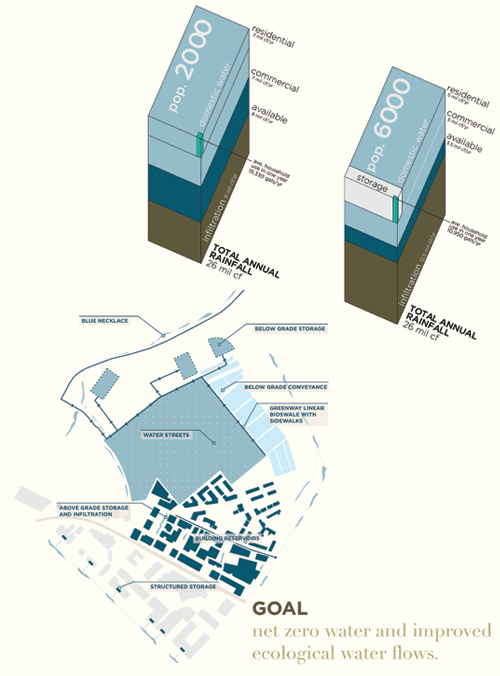Urban Strategies: Eco-Districts
For the first time in human history more than half the world’s population–3.3 billion humans– live in urban areas. This trend is expected to accelerate through 2030 when 5 billion will call cities home. While the sheer numbers are staggering; urban regions must prepare for such growth. How will they provide water, energy, waste and recreational services, ensure access to quality housing and transportation and do so in a cost effective and environmentally sound manner?
At evolveEA, we believe effective urban planning will require the simultaneous consideration of multiple interconnected variables, and that past approaches, focused on centralized infrastructure and utilities remain costly artifacts of a bygone era.
We advocate three approaches to building urban communities of the future. Urban strategies are most successful by deconstructing complex existing bureaucracy and rethinking boundaries, by involving the community to provide localized solutions and decentralized planning, and to design for engagement, whereby the design of our urban spaces actively prods people to think sustainably.
An introduction to Ecodistricts
We were first introduced to the concept of ecodistricts in 2008 while working with the Pittsburgh neighborhood of Friendship to create a low carbon planning overlay for their 2010 community master plan called the Low Carbon Neighborhood Improvement District. We used the term low carbon neighborhood to describe our vision for a future Friendship and through our research of other projects we found examples of low carbon zones, eco-blocks, and climate benefit districts.
And while the names for these projects varied, the principles for each were largely the same: they all explicitly described a new paradigm for future communities. The planning models focused net zero environmental principles and use of quantitative metrics to ensure achievement of long term environmental and community indicators simultaneously. No longer are variables such as number of local businesses or stormwater captured measured in isolation.
Ultimately, we envision ecodistricts as community scale (re)developments that provide residents with integrated and localized water, energy, and materials services. They reduce or eliminate the need for large scale centralized utilities, associated volatilities, and associated infrastructure. They focus on localized but distributed resource sharing models such as waste fired cogeneration heat and electricity plants, community wide solar arrays, passive storm and waste water techniques, and improved quality of life by maximizing greenspace and neighborhood equity. Imagine if gas prices, which currently influence almost everything you rely on, became only a marginal concern. Ecodistricts aren’t just for environmentalists; they’re for anyone who cares about preparing communities for the long haul.
At first glance one might argue that the tools to create such communities don’t exist. But a growing body of evidence suggests otherwise.

Living Cities Masterplan – Net Zero water ecologies provide this eco-district plan with sustainable opportunities
In areas like energy services, Robert and Edward Ayres suggest, “the means to a rapid doubling of energy [efficiency] already exist” and that we use only 13% of energy per unit of fuel burned. Similarly, many studies have shown that localized stormwater mitigation techniques are much more cost effective than centralized treatment.
The barriers to creating these communities in the United States are not primarily technological, but more-so institutional and cultural. The development of ecodistricts isn’t simply wishful thinking or an impossibility, but will require re-thinking traditional approaches to community planning.
So no matter the name, ecodistricts or low carbon neighborhoods, the principles are the same—here’s our road map for a new future of our communities.

